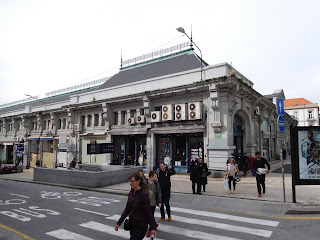I've prefaced the travel narrative of our visit to Portugal (which has been backdated) with a series called Focus on Portugal, which provides background on a European destination that's scandalously little known to Americans. Previously: "A Tuesday arrival and introduction to Porto."
When visiting a new city, it always seems like everything is very far apart, then after a day or two you realize there's far too much to fathom within a short twenty-minute stroll of base camp.
On Wednesday -- Valentine's Day -- we made ourselves as waterproof as possible and headed up the hill via Rua Flores, a street with many eateries and coffee outlets. The street leads to Porto's second of two main train stations, which is unlike any other in Europe.
The walls of the São Bento Railway Station in the historical city of Porto, Portugal have a story to tell.
The transportation hub located in the heart of Porto does more than shuttle people back and forth. The French Beaux-Arts structure holds within 20,000 magnificent azulejo tin-glazed ceramic tiles depicting Portugal’s past - its royalty, its wars, and its transportation history. The blue and white tiles were placed over a period of 11 years (1905–1916) by artist Jorge Colaço ... Five years after the station was built, the intricate tile work began. Included in the landscapes and ethnographic displays are the Battle of Valdevez (1140) and the Conquest of Ceuta (1415) along with several other important events and places that created the vibrant city that this unusual and beautiful station resides in.
Following are still photos of the train station and its tile work.
Not far away is the Mercado do Bolhão.
Mercado do Bolhão is a must see place in Porto. Located in the center of the city, this market is where you’ll find fresh produce, meat, fish and flowers. And you’ll meet the most unique characters in Porto. Dating back from 1839, when the town hall bought the land where the market now stands and defined the area as a market. As there was a small creek running though the square and there was an air bubble (“bolha”) forming on that spot, the market was named Bolhão (as in big bubble). The neoclassic building that now exists was built in 1914 and it divided the market into two floors.
February's the slow season, but there still was ample activity.
We returned to the market a few days later, when it wasn't raining.
Seemingly in Porto, for every sparse horizontal, there is an opposite and equal vertical. You'll start walking downhill and conclude the river bottom must be near, only to find yourself in a box canyon of tiled buildings; there might be a hidden staircase leading from a darkened corner, albeit one as likely to go back up the slope as extend further down.
We made an honest effort to visit Livraria Lello, an ornate bookstore said to have inspired the Harry Potter books, but the commercialization there has left the rails. Instead, a walk was taken through the nearby Jardim da Cordoaria, a classy park on a weird, misty day.
The evening's big event was the Champions Cup match between Liverpool and the hometown favorites, FC Porto, held at the city's big sports venue, the Estádio do Dragão.
We stayed close to home, opting for pizza across the street and drinks in the delightfully old-school hotel bar.
Liverpool not only won the match, but it was a rout: 5-0 to the visitors. Bar staffers were disgruntled, commenting that the big spending clubs win, while smaller markets like Porto suffer.
As an Oakland A's fan, I can fully commiserate.
Next: A stroll to the Port lodges, and our first Francesinha sandwich.













































No comments:
Post a Comment